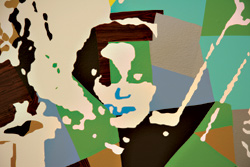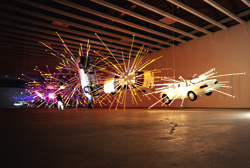The building is perched atop a University of Washington campus hill like an inaccessible fortress. The cafe is easier to find than the art. The art is often weird or unsettling. Currently on display are works by an Argentine muralist who’s covered the East Gallery wall with contact paper, and an American artist obsessed with computer technology and her own identity. In 2004, the FBI investigated an exhibiting artist, Steve Kurtz, who had included E. coli bacteria in his installation Gene(sis).
What is the Henry Art Gallery trying to pull?
Chief Curator Elizabeth Brown frankly acknowledges that presenting difficult new work can be a gamble. “You risk pissing people off. . . . I try to make sure that the Henry feels like a place to come and be surprised and maybe be shocked.” Brown came to the Henry from the Union Art Museum in Santa Barbara, Calif., in September 2000. She is both a levelheaded and passionate advocate for contemporary art and does not come across as hoodwinkable.
When railroad magnate Horace C. Henry donated his private collection of 172 works, primarily paintings, to UW in 1927, the Henry became the first public art gallery in Washington. From early on, it championed modern art, showing groundbreaking work by Dalí, Picasso, Kandinsky, and Klee. In 1997, in a $17.5 million renovation, it expanded from 10,000 square feet to over 40,000 in a design by Charles Gwathmey, who grafted a steel, glass, and cut-stone extension to the existing Gothic building. Unlike SAM or the Frye, the Henry focuses exclusively on where art may be heading, rather than offering didactic history lessons. Its mission, Brown says, is “making it possible for people to have really intense experiences with works of art. Part of the social service that we provide is supporting and presenting contemporary art in all its complexity.”
After seeing a few of the Henry’s recent exhibits, “complexity” may seem a creative euphemism for head-scratching obscurity. The current installation by Santiago Cucullu is as complex and intangible as its title—The Fates Await: (Serious Delirium, or You Will Die Tomorrow). Inspired by the 1920 German expressionist film The Cabinet of Dr. Caligari, its colorful contact paper cutouts hint at characters from the movie, with wooden boxes of varying sizes strewn in front. Visitors are welcome to move them about, yet nothing tells them to do so. Aluminum frames stretch across the floor like disjointed oversized tripods; airplane blankets hang across the open wall, partially obscuring the gallery’s security camera. Extensive wall text describes the work’s sources.
Alongside all this is a comprehensive collection of work by innovative multimedia conceptual artist Lynn Hershman Leeson. Much of it is creepy, some quite brilliant, and a lot ahead of its time, as Leeson explores such edgy topics as cloning and creating false realities using Photoshop or fake identities.
The Henry also takes on the hit-or-miss risk of commissioning work from new artists. “Some of the things have turned out better than others,” says Brown. “What we’re encouraging them to do is grow. If it doesn’t necessarily work out at first, that’s OK.” The Henry’s choices lately have been mixed. The clever “150 Works of Art,” designed by Annie Han and Daniel Mihalyo, presents 150 unrelated paintings uniformly on plain wood and metal stands, with the title, year, and artist’s name stamped on the back, though the art on display is a hodgepodge of not necessarily major work.
It is important for a progressive city like Seattle to have a contemporary art institution to challenge and expand the public’s imagination. At the very least, the Henry is positing the question over and over: What is art? Can it be one man’s fragmented thoughts inspired by an art-house movie expressed in contact paper, wooden blocks, and aluminum poles? How about a woman’s wax mask of herself? Perhaps more important than the art itself, says Brown, is the individual observer’s response to it. Delight, confusion, grief, even anger are all valid responses. No reaction at all would indicate failure.
“Sometimes, something upsetting or incomprehensible sticks with you,” says Brown. “The things that make a big impact in you almost always don’t make sense to you when you first see them. Many people have told me that [the 1992 show by American installationist] Ann Hamilton was one of the most memorable shows they have ever seen.” In Accountings, Hamilton created a visceral environment out of soot, steel, and a glass display case filled with wax heads. In 2003, light and space artist James Turrell achieved a similar emotional impact by filling a 4,000-square-foot gallery with mesmerizing blue light; its source was mysterious and shadows miraculously nonexistent. “The blue room was utterly distinct,” says Brown. “People still talk about how it changed their lives.”
And there’s one important caveat to contemporary art: Often only in hindsight can you know whose work was indeed visionary, and whose was merely passing provocation that sucked in a couple of curators along the way. In San Francisco, some 10 years ago, the public turned up their noses at a proposed Richard Serra sculpture to be placed outside the Palace of the Legion of Honor museum. In the preliminary sketches, it seemed a slab of shapeless steel; only years later, when I experienced his towering Snake sculpture in the vast “Boat Gallery” of the Bilbao Guggenheim, did I finally “get” Serra. The visionless philistines of San Francisco, myself among them, had made a mistake, and it was truly our loss.








